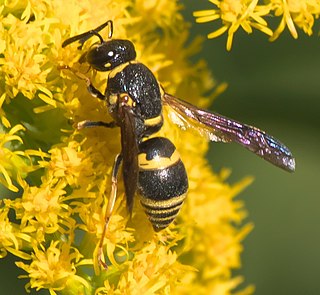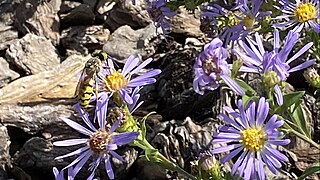
Sawflies are wasp-like insects that are in the suborder Symphyta within the order Hymenoptera, alongside ants, bees, and wasps. The common name comes from the saw-like appearance of the ovipositor, which the females use to cut into the plants where they lay their eggs. The name is associated especially with the Tenthredinoidea, by far the largest superfamily in the suborder, with about 7,000 known species; in the entire suborder, there are 8,000 described species in more than 800 genera. Symphyta is paraphyletic, consisting of several basal groups within the order Hymenoptera, each one rooted inside the previous group, ending with the Apocrita which are not sawflies.

The Ichneumonidae, also known as ichneumon wasps, ichneumonid wasps, ichneumonids, or Darwin wasps, are a family of parasitoid wasps of the insect order Hymenoptera. They are one of the most diverse groups within the Hymenoptera with roughly 25,000 species described as of 2016. However, this likely represents less than a quarter of their true richness as reliable estimates are lacking, along with much of the most basic knowledge about their ecology, distribution, and evolution. It is estimated that there are more species in this family than there are species of birds and mammals combined. Ichneumonid wasps, with very few exceptions, attack the immature stages of holometabolous insects and spiders, eventually killing their hosts. They thus fulfill an important role as regulators of insect populations, both in natural and semi-natural systems, making them promising agents for biological control.

The Braconidae are a family of parasitoid wasps. After the closely related Ichneumonidae, braconids make up the second-largest family in the order Hymenoptera, with about 17,000 recognized species and many thousands more undescribed. One analysis estimated a total between 30,000 and 50,000, and another provided a narrower estimate between 42,000 and 43,000 species.

Anomalon is a large genus of parasitoid wasps belonging to the family Ichneumonidae. This may be the only genus in the tribe Anomalonini, although Neogreeneia Viereck, 1912 is sometimes considered a valid genus of the tribe.
Stictiella is a genus of sand wasps in the family Crabronidae. There are at least 14 described species in Stictiella.
Chrysis provancheri is a species of cuckoo wasp in the family Chrysididae.
Crabro cingulatus is a species of square-headed wasp in the family Crabronidae. It is found in Central America and North America.

Euodynerus foraminatus is a species of potter or mason wasp in the family Vespidae. It is notable as a hymenopteran with fertile diploid males.

Auplopus mellipes is a species of spider wasp in the family Pompilidae.

Tromatobia ovivora is a species of ichneumon wasp in the family Ichneumonidae.

Kokkocynips imbricariae, the banded bullet gall wasp, is a species of gall wasp in the family Cynipidae.

Echthrus niger is a species of ichneumon wasp in the family Ichneumonidae.

Echthrus is a genus of ichneumon wasps in the family Ichneumonidae.
Sapyga louisi is a species of a club-horned wasp in the family – Sapygidae. Adults feed from flowers and the larvae are kleptoparasites of leaf cutter bee larvae, including those of Heriades carinata.

Ectemnius lapidarius is a species of square-headed wasp in the family Crabronidae. It is found in Africa, Europe and Northern Asia, North America, and Southern Asia.
Andricus quercusfoliatus, the leafy oak gall wasp, is a species of gall wasp in the family Cynipidae.
Hoplisoides hamatus is a species of sand wasp in the family Crabronidae. It is found in North America.
Epinysson mellipes is a species of wasp in the family Crabronidae. It is found in North America.

Steniolia is a genus of sand wasps in the family Crabronidae. There are about 15 described species in Steniolia.

Agathis is a genus of braconid parasitoid wasps. This genus was established by Latreille in 1804, and the type species is Agathis malvacearum Latreille, 1805. There are at least forty six species of Agathis in the western palearctic region.













